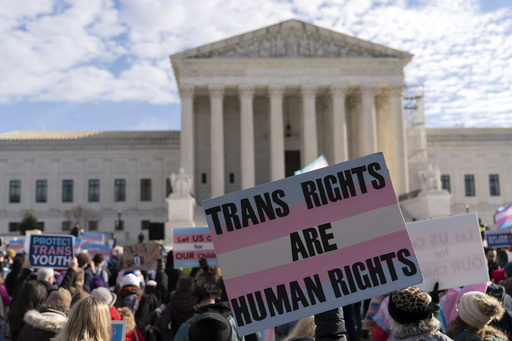
President Donald Trump has set his sights on transgender and nonbinary individuals through a series of executive orders following his return to office, employing pointed rhetoric in his declarations. In one particular executive order, he contended that “medical professionals are maiming and sterilizing a growing number of impressionable children under the radical and false claim that adults can change a child’s sex.” This stance marks a significant departure from the policies of former President Joe Biden’s administration and from the position of major medical institutions that support gender-affirming care.
According to Sruti Swaminathan, an attorney with the American Civil Liberties Union, the implementation of the orders must go through federal rulemaking processes, which are lengthy and typically allow for public feedback. Sarah Warbelow, legal director at the Human Rights Campaign, emphasized the impact of such rhetoric from the nation’s leader, stating that it sends a troubling signal to the public regarding attitudes toward transgender individuals.
Key developments stemming from Trump’s recent actions include the official recognition of only male and female identities. On his first day back in office, Trump launched an extensive order that fundamentally altered how his administration would interact with transgender rights. The order posits that only two immutable sexes—male and female—will be recognized by the government, asserting that this is crucial to protecting women’s rights. The document further argues that efforts to distance biology from gender are fundamentally harmful to women’s dignity and safety.
Federal agencies quickly aligned with the new directives. For instance, Andrea Lucas, the acting chair of the U.S. Equal Employment Opportunity Commission, announced plans to remove identity pronouns from employee profiles and eliminate the “X” gender marker from discrimination claims. Lucas stated, “Biology is not bigotry. Biological sex is real, and it matters.” Subsequently, language concerning “gender ideology” was scrubbed from federal websites, and the term “gender” was replaced by “sex” in accordance with the executive order. Changes also included the Bureau of Prisons ceasing to report on transgender individuals in custody and the Centers for Disease Control and Prevention removing educational content aimed at supporting transgender and nonbinary students.
Research indicates that less than 1% of adults identify as transgender, and about 2% are intersex, meaning they possess physical traits that do not neatly fit conventional definitions of male or female.
In another facet of his executive order, Trump addressed passport gender markers, directing the State Department to halt processing requests for passports that do not align with the newly defined genders. This resulted in the termination of the “X” designation option for individuals who do not identify strictly as male or female, nor will the agency facilitate changes in gender markers for transgender individuals.
Furthermore, Trump’s directive suggested relocating transgender women from women’s federal prisons to men’s facilities, with reports indicating such transfers may be taking place according to lawyers associated with the Human Rights Campaign. In contrast, there have been attempts to legally challenge this policy, with a federal judge ruling that a transgender woman in a Massachusetts prison should remain in the women’s prison and continue receiving gender-affirming care during the litigation period.
The executive orders also portend a potential revival of the ban on transgender individuals in the military. Trump instructed Defense Secretary Pete Hegseth to establish new guidelines on this front, asserting that being transgender undermines the military’s core values. During his first term, Trump had enacted a similar ban, which was subsequently halted by the courts.
Additionally, Trump’s administration is advocating against federal funding for gender-affirming medical treatment for transgender youth under 19, which encompasses puberty blockers, hormone therapy, and gender-affirming surgeries, the latter being a rare occurrence for minors. Should this order be fully enforced, it would significantly affect government healthcare coverage, including Medicaid and TRICARE for military families.
In a separate executive order, Trump has moved to prohibit schools from supporting student social transitions, instructing the Education Department to devise measures against what he terms “radical indoctrination” in education. This would prevent the use of federal funding for curricula that advocate for the concept of fluid gender identities and would also bar schools from requiring staff to address transgender students using names or pronouns that match their gender identity. Many districts have already instituted such requirements to combat the practice of deadnaming, which is often viewed as disrespectful and harmful.

